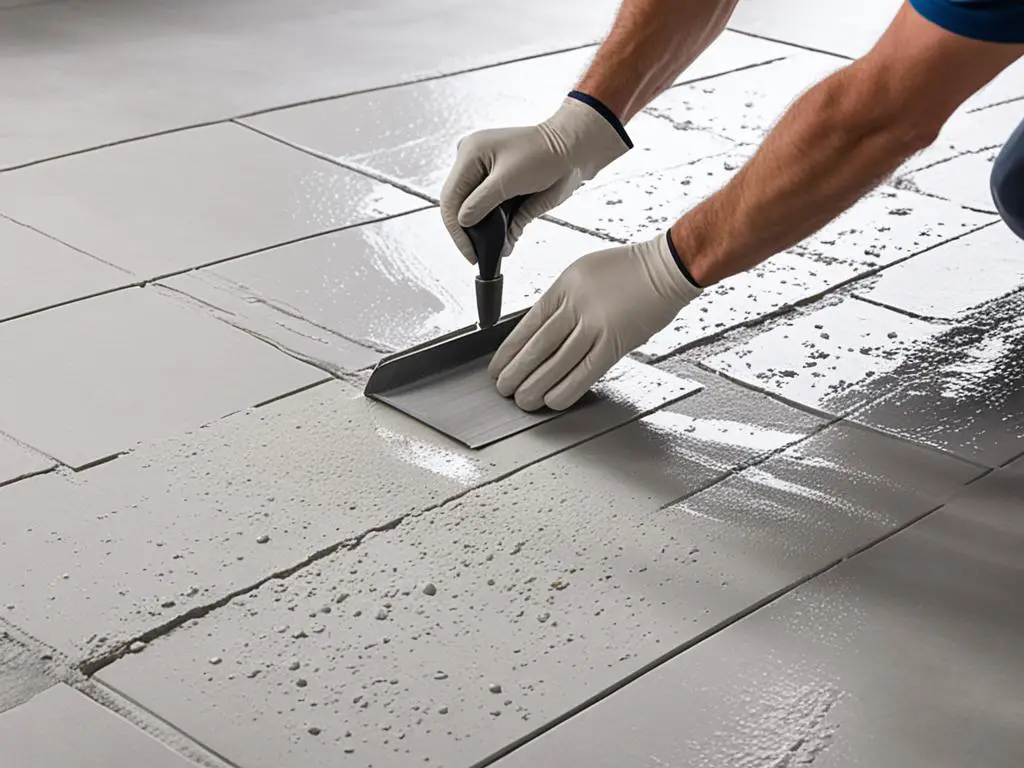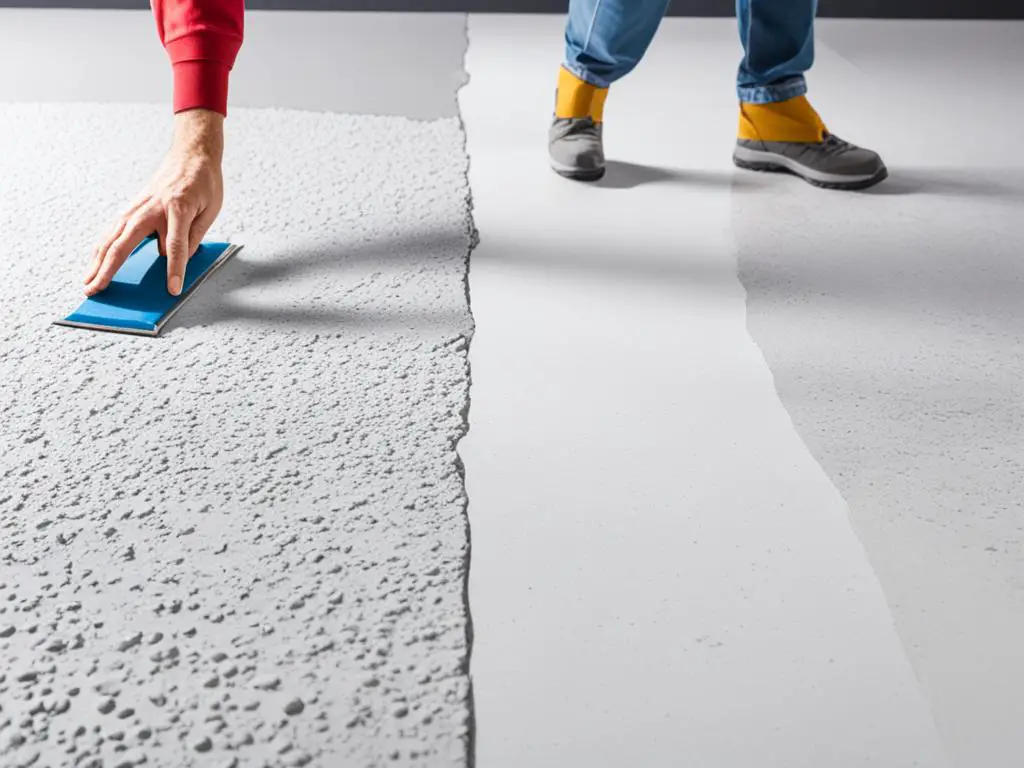When it comes to floor installation, choosing the right material can make all the difference. Two commonly used options are thinset and self-leveling cement, each with its own unique properties and applications. By understanding the differences between thinset and self-leveling cement, you can make an informed decision for your flooring project.
Thinset, also known as thinset mortar, is an adhesive made up of cement, sand, and a polymer that enhances its bonding strength. It is typically used for tile installation, especially in smaller, more level areas. On the other hand, self-leveling cement is a blend of cement, sand, and additives that allows it to level itself with minimal intervention. This type of cement is ideal for larger surfaces, such as concrete slabs, or areas that are not perfectly level.
So, which is better for your flooring needs? Let’s delve deeper into the differences between thinset and self-leveling cement, weighing the pros and cons of each.
Key Takeaways:
- Thinset is a cement-based adhesive used primarily for tile installation in smaller, level areas.
- Self-leveling cement is a mixture that can flow and level itself, making it suitable for larger surfaces or uneven areas.
- Thinset provides better adhesion and is suitable for rigid flooring materials like tile, ceramic, or stone.
- Self-leveling cement is ideal for flexible flooring materials like vinyl, laminate, or wood that require a level surface.
- The application process and cost differ between thinset and self-leveling cement, with self-leveling cement being more expensive and time-consuming.
Understanding the Properties of Thinset and Self-Leveling Cement
When it comes to floor installation, it’s important to choose the right materials to ensure a successful and long-lasting result. Two commonly used options are thinset and self-leveling cement, each offering unique advantages for specific applications. Understanding the properties of these materials is essential in making an informed decision for your flooring project.
Advantages of Thinset for Tile Installation
| Advantages of Thinset |
|---|
| 1. Strong bonding ability |
| 2. Suitable for smaller, more level areas |
| 3. Ideal for tile installation |
Thinset is a type of adhesive composed of cement, sand, and a polymer that enhances its bonding ability. This adhesive creates a strong bond between the tile and the substrate, ensuring durability and preventing tile movement. Thinset is particularly effective for smaller areas that are relatively level, making it a popular choice for tile installations. Whether it’s a bathroom, kitchen backsplash, or any other tile project, thinset provides reliability and stability.
Benefits of Self-Leveling Compound for Flooring
| Benefits of Self-Leveling Compound |
|---|
| 1. Ability to level out by itself |
| 2. Suitable for large surfaces |
| 3. Provides a stable base for flooring |
On the other hand, self-leveling cement is a mixture of cement, sand, and additives that allow it to level out on its own with minimal intervention. It is specifically designed for use on large surfaces, such as concrete slabs or areas that are not level, providing a smooth and even base for flooring installation. The self-leveling properties of this compound ensure a seamless and stable result, making it an excellent choice for flooring projects.
Both thinset and self-leveling compound have their unique benefits and applications. Thinset is ideal for tile installation in smaller, level areas, while self-leveling compound is perfect for larger surfaces and areas that require leveling. Consider the specific requirements of your project and consult with a flooring professional to determine the best material for your needs.

Differences in Consistency and Floor Coverings
One major difference between thinset and self-leveling cement is their consistency. Self-leveling cement is thinner and more fluid, which allows it to flow and level itself out. However, it does not have the ability to hold flooring in place. Thinset, on the other hand, has a thicker consistency that allows it to adhere to surfaces and hold flooring in place.
The choice between the two also depends on the type of floor covering being installed. Flexible flooring like vinyl, laminate, and wood may require a more level surface, making self-leveling cement a better choice. Rigid flooring like tile, ceramic, or stone can bridge small imperfections in the subfloor, so thinset is often used for these applications.

| Factors | Self-Leveling Cement | Thinset |
|---|---|---|
| Consistency | Thin and fluid | Thicker and more adhesive |
| Floor Coverings | Flexible flooring like vinyl, laminate, and wood | Rigid flooring like tile, ceramic, or stone |
Considerations in Application and Cost
When it comes to choosing between thinset and self-leveling cement for your flooring project, it’s essential to consider the application process and cost factors. Each material has its own unique characteristics and requirements, which can impact the overall outcome and budget of your project.
Application Process
The application process for thinset and self-leveling cement differs in terms of consistency and technique. Self-leveling cement is poured onto the subfloor and naturally seeks its own level, ensuring a smooth and even surface. However, it still requires spreading or agitation with tools like a squeegee or a spiked roller to achieve the desired results.
On the other hand, thinset takes more time to apply due to its thicker consistency. It is spread onto the subfloor using a notched trowel, creating ridges for better adhesion. The ridges allow for a stronger bond between the flooring material and the subfloor, providing added stability.
Cost Considerations
When it comes to cost, self-leveling cement is generally more expensive than thinset. This is primarily due to the drying time required for self-leveling cement before any flooring can be placed on top. The extra time required for the material to set can add to the overall project timeline and cost.
On the other hand, thinset is less expensive and more budget-friendly. It can be applied simultaneously with the flooring, saving time and reducing labor costs. This makes thinset a popular choice for cost-conscious homeowners and contractors.
To summarize, the application process and cost considerations can play a significant role in choosing between thinset and self-leveling cement. While self-leveling cement may provide a smoother and more even surface, it comes at a higher cost and requires additional time for drying. Thinset, on the other hand, is a cost-effective option that can be applied concurrently with the flooring installation, making it a popular choice for many projects.
Conclusion
When deciding between thinset and self-leveling cement for your flooring project, it’s essential to consider your specific requirements. Thinset is the ideal choice for smaller, level areas, and it is commonly used for tile installation. Its thicker consistency allows for better adhesion, making it perfect for rigid flooring materials like tile, ceramic, or stone.
On the other hand, self-leveling cement is best suited for larger surfaces or areas that are not level. Its thinner and more fluid consistency allows it to flow and level out, providing a more even and stable base for flexible flooring options like vinyl, laminate, and wood.
When making your decision, take into account factors such as the type of floor covering, application process, cost, and the specific requirements of your project. By understanding the differences and properties of thinset and self-leveling cement, you can make an informed choice and ensure a successful flooring installation.
FAQ
What is the difference between thinset and self-leveling cement?
Thinset is a thicker adhesive used for smaller, level areas, especially for tile installation. Self-leveling cement is a thinner, more fluid material that is used on large surfaces or areas that are not level.
When should I use thinset?
Thinset is typically used for rigid flooring like tile, ceramic, or stone. It can bridge small imperfections in the subfloor and hold flooring in place.
When should I use self-leveling cement?
Self-leveling cement is ideal for flexible flooring like vinyl, laminate, or wood. It provides a more level and stable base for these types of flooring.
How do I apply thinset?
Thinset is applied with a notched trowel, creating ridges for better adhesion. It takes more time to apply due to its thicker consistency.
How do I apply self-leveling cement?
Self-leveling cement is poured onto the subfloor and seeks its own level, but it still requires spreading or agitation with a tool like a squeegee or a spiked roller.
Which is more expensive, thinset or self-leveling cement?
Self-leveling cement is usually more expensive than thinset, as it requires drying time before any flooring can be placed on top.



